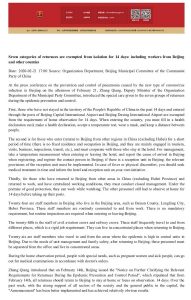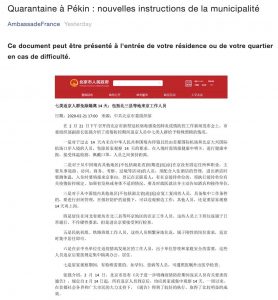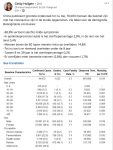China more stable
While China looks like becoming more stable, we see COVID-19 spreading over the world. Read international news and you see how many new cases in new countries are popping up. Frightening is the fact we may not even know when and how the virus will rampage in South America and Africa where detection is poor. Once it starts there, good luck. The spread in Italy and Iran with high death rates is a warning for what to expect next.
No time for optimism.
Maybe China will be the first to more or less go back to “normal”, but when? I believe we need at least to look at June at best more a more normal situation.
Even if China restarts…
People ignore the enormous impact of the virus already today, as I pointed out repeatedly. Container ships are being systematically stopped to sail from China to its export markets. Logistics and supply chains: chaos could get even worse.
The financial damage in China is still underestimated, forget all the nice outlooks in China Daily. Consumers will not restart spending that soon as many are losing income and will even get bankrupt. Real estate, tourism, car industry, steel industry, F&B, entertainment and so on: damage will take a long time to repair. So many people losing income.
Export business still is facing shipment issues and face-to-face business restrictions.
See the view from PwC:
https://mp.weixin.qq.com/s/q9xPF4vhbIHD2yvQOzv4qw
The overview is interesting as it tries to address the different economic sectors and how they are being affected. I quote:
“In the short term, the impact of the virus on China’s economic growth will be very obvious. Since the outbreak, many domestic and foreign institutions have made their estimations. Most of them believe that the GDP growth rate in the first quarter may be about 4%, a decline by about 2 percentage points. The growth rates in the next three quarters will gradually pick up depending on when the outbreak ends, and the annual GDP growth will show a “V-shaped” pattern.
All things considered, this outbreak will far surpass SARS 17 years ago in its impact on the economic growth. On the one hand, the scale of this outbreak as of now is already much larger than the previous one, whether in terms of confirmed cases or deaths. On the other hand, as compared with the SARS period, things have become very different in terms of growth environment, industrial structure, and the room for policy stimulus, which are less favorable to offsetting the impact than years before. However, like any disaster, the impact of the Novel Coronavirus disease is sure to be temporary. When the outbreak is over, the economic growth will soon return to normal as determined by the general course of things.
In light of the prevailing analyses and estimations of domestic and foreign institutions, we believe that if the outbreak could be largely over in late March or early April, the growth rates in the four quarters of this year may reach 4.5%, 5.0%, 5.8%, and 5.7% respectively. The annual growth rate may be 5.2-5.3%.”
The million dollar question is: “When the outbreak is over, the economic growth will soon return to normal…” Yeah. WHEN WHEN.
I guess this hotel is having bad business too.
And in the U.S. …
Coronavirus: US outbreak now inevitable, leading American health official warns:
“It is not so much a question of if, but when. Data over the last week has raised our expectation that we are going to have community spread here.” says Nancy Messonnier of the Centers for Disease Control and Prevention in USA.
SCMP, 26 February 2020
https://www.scmp.com/news/china/society/article/3052337/coronavirus-us-outbreak-now-inevitable-top-american-health
An outbreak of the coronavirus in the United States is now inevitable, the leading US health official said on Tuesday, as infections and deaths related to the Covid-19 disease continue to rise beyond China and signs point toward a global pandemic.
Of course we all hope it won’t spread that much in North America. Cross fingers.
As usual, genius Trump has other ideas. Idiot.
As for a possible vaccine most agree it will not be available this year. Don’t dream…
About my posts
If you arrive here, it means you did read all.
Just to say, my only goal is to keep my connections and friends informed about our situation here. There is too much crap going around. People are so superficial and never read or research stuff as they should. I try to scan carefully the news to give a correct and balanced view.
Yes I have my personal views, like on how to use masks. I don’t share the hysteria around it, actually using the same (good) mask for one week but always heating up when back to kill the virus. See the articles and posts about it that prove my point. Most important are your hands. And never touch your face unless back home and after disinfecting your hands (and mobile).






































